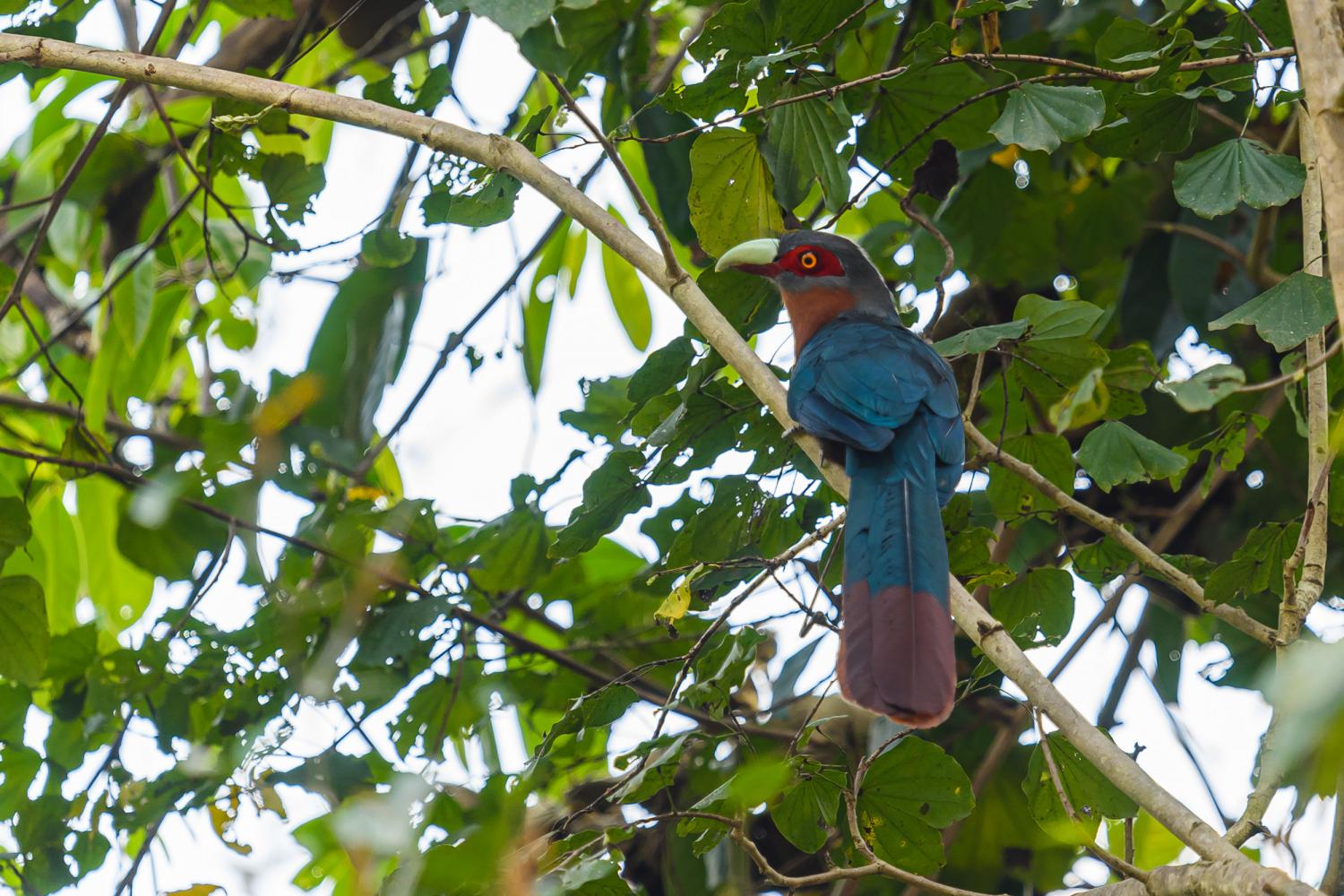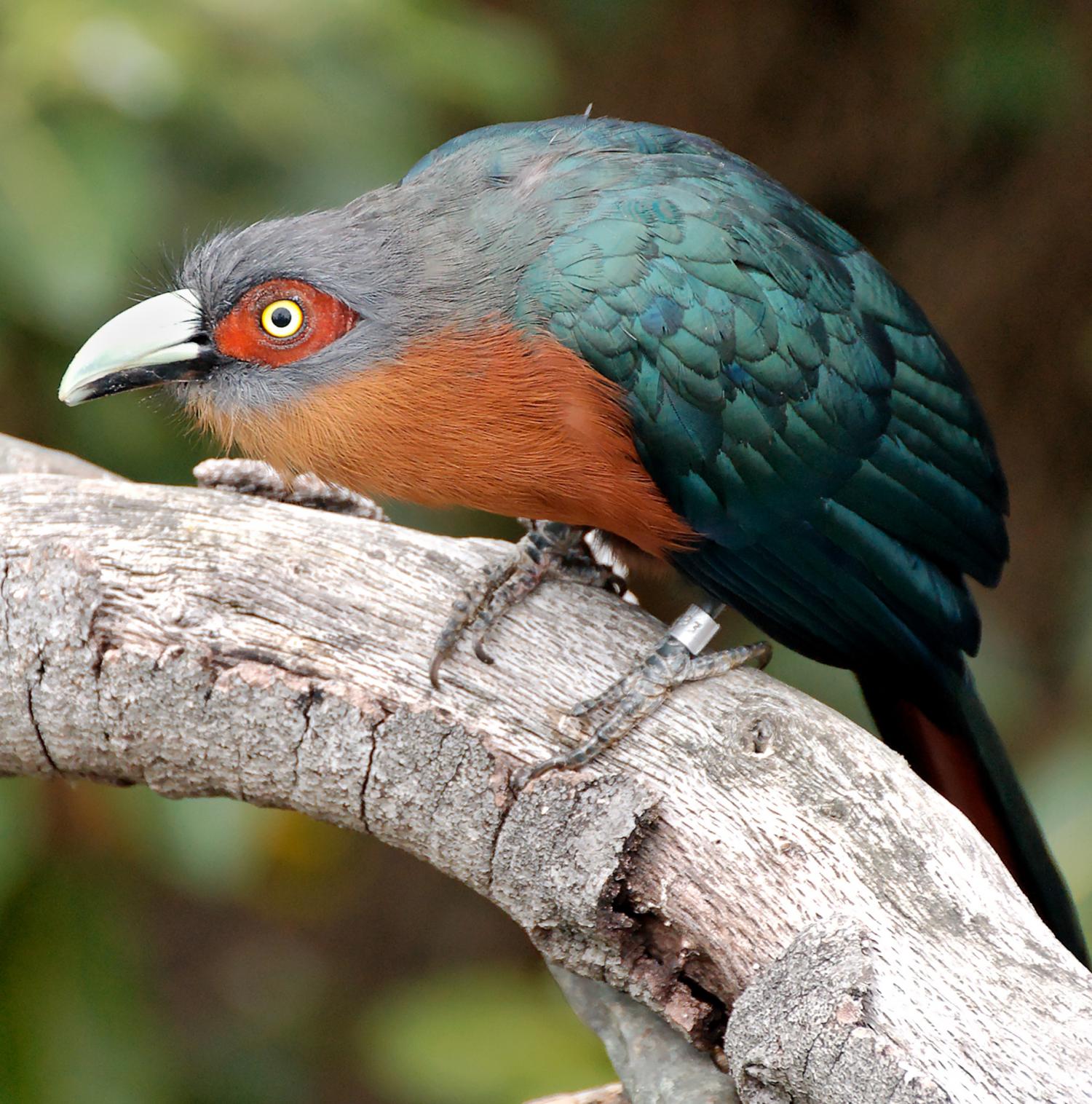Species of Thailand
Chestnut-breasted malkoha
Phaenicophaeus curvirostris
George Shaw, 1810
In Thai: นกบั้งรอกเขียวอกแดง
The chestnut-breasted malkoha (Phaenicophaeus curvirostris) is a species of cuckoo in the family Cuculidae. Found in Southeast Asia from Myanmar through to eastern Java, the Philippines and Borneo, it is a large cuckoo measuring up to 49 cm with grey and dark green upperparts and chestnut underparts, and a large curved pale upper mandible. The male and female are similar in plumage. Unlike many cuckoos, it builds its nest and raises its own young.
Taxonomy
The chestnut-breasted malkoha was first described from a specimen collected in western Java by English naturalist George Shaw in 1810 as Cuculus curvirostris, before the genus Phaenicophaeus was erected by English naturalist James Francis Stephens in 1815. Its specific epithet is derived from the Latin words curvus "curved", and rostrum "beak". The genus name is derived from the ancient Greek phoiniko- "crimson", and "eyes" or "face", referring to the red-faced malkoha. However, the 'œ' was transcribed incorrectly as 'æ'.
Subspecies
Six subspecies are recognised:
- P. c. singularis: from southern Myanmar and Thailand, through the Malay Peninsula and into Sumatra, as well as the Anambas archipelago.
- P. c. oeneicaudus: from western Sumatra Islands.
- P. c. curvirostris: from central and western Java.
- P. c. deningeri: from eastern Java and Bali.
- P. c. microrhinus: from Bangka Island and Borneo.
- P. c. harringtoni: from Palawan, Balabac, Calamian and Dumaran islands of the Palawan province of the western Philippines.
Description
Measuring 42 - 49 cm in length, the chestnut-breasted malkoha has a large, curved, pale yellow upper mandible and darker red or black lower mandible, and a bare red patch of rough skin around the eye. The head is grey and wings are dark green fading to blue with age. Its underparts and rump are chestnut, and feet are dark grey. Little sexual dimorphism is seen, as the male and female are similar in plumage, although the male has a pale blue iris and the female yellow.
Distribution and habitat
It is found in Brunei, Indonesia, Malaysia, Myanmar, the western Philippines, and southern Thailand.
Its natural habitats are subtropical or tropical moist lowland forests and subtropical or tropical mangrove forests. It resides mainly in the middle story in dense foliage. Much of its forest habitat is being cleared.
Feeding
It eats small vertebrates, such as small lizards, frogs, and baby birds, and insects, including caterpillars, grasshoppers, cicadas, stick insects, mantises, cockroaches, beetles, and bugs, as well as spiders and small crabs.
Breeding
Unlike many cuckoos, the chestnut-breasted malkoha builds its nest and raises its own young. Breeding season varies by location, from August to December in Borneo, to January to September in Southeast Asia. The male and female pair up and build a nest around 35 cm diameter of small branches and twigs, with a leaf-lined depression or cup around 11 cm in diameter and 5 cm deep. Two or three matte white eggs measuring 34 x 28 mm are laid. Both the female and male incubate the eggs, which usually hatch around 13 days after being laid. Young birds remain in the nest for around 11 days, during which time they are fed by both parents.
This article uses material from Wikipedia released under the Creative Commons Attribution-Share-Alike Licence 3.0. Eventual photos shown in this page may or may not be from Wikipedia, please see the license details for photos in photo by-lines.
Category / Seasonal Status
BCST Category: Recorded in an apparently wild state within the last 50 years
BCST Seasonal status: Resident or presumed resident
Scientific classification
- Kingdom
- Animalia
- Phylum
- Chordata
- Class
- Aves
- Order
- Cuculiformes
- Family
- Cuculidae
- Genus
- Phaenicophaeus
- Species
- Phaenicophaeus curvirostris
Common names
- Thai: นกบั้งรอกเขียวอกแดง
Subspecies
Phaenicophaeus curvirostris curvirostris, George Shaw, 1810
Range: From central and western Java.
Phaenicophaeus curvirostris deningeri, Erwin Stresemann, 1912
Range: From eastern Java and Bali.
Phaenicophaeus curvirostris harringtoni, Richard Bowdler Sharpe, 1877
Range: From Palawan, Balabac, Calamian and Dumaran islands of the Palawan province of the western Philippines.
Phaenicophaeus curvirostris microrhinus, Hans Hermann Carl Ludwig von Berlepsch, 1895
Range: From Bangka Island and Borneo.
Phaenicophaeus curvirostris oeneicaudus, Jean Baptiste Édouard Verreaux & Jules Pierre Verreaux, 1855
Range: From western Sumatra Islands.
Phaenicophaeus curvirostris singularis, Carl Parrot, 1907
Range: From southern Myanmar and Thailand, through the Malay Peninsula and into Sumatra, as well as the Anambas archipelago.
Conservation status

Least Concern (IUCN3.1)
Photos
Please help us review the bird photos if wrong ones are used. We can be reached via our contact us page.
Range Map

- Ao Phang-Nga National Park
- Bang Lang National Park
- Hala-Bala Wildlife Sanctuary
- Huai Yang Waterfall National Park
- Kaeng Krachan National Park
- Kaeng Krung National Park
- Khao Banthat Wildlife Sanctuary
- Khao Chong
- Khao Luang National Park
- Khao Nam Khang National Park
- Khao Nan National Park
- Khao Phanom Bencha National Park
- Khao Phra - Bang Khram Wildlife Sanctuary
- Khao Phra Thaeo Wildlife Sanctuary
- Khao Pu - Khao Ya National Park
- Khao Sok National Park
- Khlong Saeng Wildlife Sanctuary
- Kromluang Chumphon Wildlife Sanctuary
- Kui Buri National Park
- Mueang Krabi District, Krabi
- Mueang Phuket District, Phuket
- San Kala Khiri National Park
- Sri Phang-nga National Park
- Tai Rom Yen National Park
- Thale Ban National Park
- Ton Nga-Chang Wildlife Sanctuary
- Ton Pariwat Wildlife Sanctuary
- Wang Mai Forest Restoration Project
- Yan Ta Khao District, Trang

